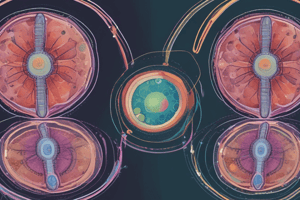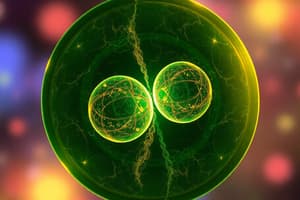Podcast
Questions and Answers
What is meiosis?
What is meiosis?
Meiosis is the process of sex cell division.
What is produced by mitosis?
What is produced by mitosis?
Parent cells divide and produce two daughter cells in mitosis.
What is cell division important for?
What is cell division important for?
Cell division is important in tissue growth, repair, and replacement.
What happens in the G1 phase of interphase?
What happens in the G1 phase of interphase?
What happens in the S phase?
What happens in the S phase?
What are the two major events that take place once interphase is complete?
What are the two major events that take place once interphase is complete?
What occurs in prophase?
What occurs in prophase?
What occurs during anaphase?
What occurs during anaphase?
What is Cytokinesis
What is Cytokinesis
Flashcards
Mitosis
Mitosis
Cell division resulting in two daughter cells with the same number and kind of chromosomes as the parent nucleus.
Meiosis
Meiosis
Cell division that results in four daughter cells each with half the number of chromosomes of the parent cell, as in the production of gametes and plant spores.
Interphase
Interphase
The phase of the cell cycle in which the cell grows, replicates its DNA, and prepares for cell division.
Chromosomes
Chromosomes
Signup and view all the flashcards
Prophase
Prophase
Signup and view all the flashcards
Metaphase
Metaphase
Signup and view all the flashcards
Anaphase
Anaphase
Signup and view all the flashcards
Telophase
Telophase
Signup and view all the flashcards
Cytokinesis
Cytokinesis
Signup and view all the flashcards
Study Notes
- Mitosis and meiosis are the two types of cell division.
- Meiosis produces sex cells: egg (female) and sperm (male).
- Mitosis occurs in all other cells in the body.
- In mitosis, parent cells divide to produce two daughter cells.
- Cell division is important for tissue growth, repair, and replacement.
Interphase Sections
- G1 Phase: New organelles are produced, protein levels increase, and centrioles start to replicate.
- S Phase: DNA replication occurs and DNA is unwound by enzymes.
- G2 Phase: Centriole replication finishes, preparing for cell division.
- After interphase, the mitotic phase begins
- Mitosis is the division of the nucleus.
- Cytokinesis is the division of cytoplasm.
- The M phase has 4 phases.
Mitosis Phases
- Prophase: Chromatin condenses into tightly packed DNA and proteins, forming chromosomes.
- Metaphase: Spindle fibers attach to chromosomes, aligning them at the cell's equatorial plate.
- Anaphase: Centromeres holding sister chromatids separate, pulling them to opposite poles via spindle fibers, turning each into its own chromosome; cytokinesis begins.
- Telophase: A new nuclear envelope forms, nucleolus reforms, spindle fibers break down, and chromosomes uncoil into chromatin as cytokinesis continues, resulting in two new daughter cells, concluding cell division.
- Cytokinesis is the final step in cell division.
Studying That Suits You
Use AI to generate personalized quizzes and flashcards to suit your learning preferences.





